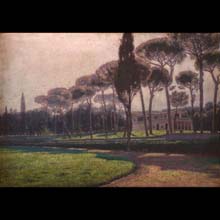
material: oil on canvas
dimensions: 35,5 × 50 cm
description: Towards the end of his life, Aleksander Gierymski painted mainly urban views at different times of the day, every time taking up a different artistic challenge. He tried to capture the changing and complex relationship between light and colour. Moving between Munich, Paris or Rome and other Italian cities, the artist produced views of historic buildings and squares painted in strong midday sun, highlighting architectural details. The artist also portrayed dim and cold interiors of churches, with light seeping through colourful stained glass windows. Finally, he painted park avenues in the morning light, opalescent in the mist, sunk in the stifling air of the hot afternoon or imbued with the pinkish glow of twilight. The artist, endowed with unusual colour sensitivity enabling him to perceive the tiniest colour nuances, captured and recorded delightful fleeting effects of nature. Nevertheless, his technique was different from that of Impressionists, who resigned from the realism of depiction in favour of capturing the fleeting impression. Thanks to his ability of harmonizing the picture by means of colour, subtle colour harmonies achieved through hardly visible gradations of tones and smooth value transitions, the artist was able to combine the faithfulness to technical perfection with the monumentality of depicted scenes, which resulted in a uniform painting vision. These works acquired a special mood triggering reverie, typical of Symbolist landscapes of the turn of the centuries. With a view to showing subtle differences in the play of light and shadow, Gierymski sometimes painted the same motif over and over again. The views of the garden park surrounding the Villa Borghese in Rome illustrate such changes in the intensity of light. In the first one, the afternoon sun has faded the colour of the sky. It seeps through the branches of stone pines casting patchy shadows on avenues and lawns. The other painting, executed after sunset, shows this moment of dusk when there is still some light in the sky. As a result, the scene is permeated with a pink and violet glow, slightly subdued by the greyness of the approaching dark. Wacława Milewska
exposition: The Gallery of 19th Century Polish Art in Sukiennice,
The Cloth Hall, 1, Main Market Square
key: Realism, polish impressionism, beginnings of symbolism >>>
dimensions: 35,5 × 50 cm
description: Towards the end of his life, Aleksander Gierymski painted mainly urban views at different times of the day, every time taking up a different artistic challenge. He tried to capture the changing and complex relationship between light and colour. Moving between Munich, Paris or Rome and other Italian cities, the artist produced views of historic buildings and squares painted in strong midday sun, highlighting architectural details. The artist also portrayed dim and cold interiors of churches, with light seeping through colourful stained glass windows. Finally, he painted park avenues in the morning light, opalescent in the mist, sunk in the stifling air of the hot afternoon or imbued with the pinkish glow of twilight. The artist, endowed with unusual colour sensitivity enabling him to perceive the tiniest colour nuances, captured and recorded delightful fleeting effects of nature. Nevertheless, his technique was different from that of Impressionists, who resigned from the realism of depiction in favour of capturing the fleeting impression. Thanks to his ability of harmonizing the picture by means of colour, subtle colour harmonies achieved through hardly visible gradations of tones and smooth value transitions, the artist was able to combine the faithfulness to technical perfection with the monumentality of depicted scenes, which resulted in a uniform painting vision. These works acquired a special mood triggering reverie, typical of Symbolist landscapes of the turn of the centuries. With a view to showing subtle differences in the play of light and shadow, Gierymski sometimes painted the same motif over and over again. The views of the garden park surrounding the Villa Borghese in Rome illustrate such changes in the intensity of light. In the first one, the afternoon sun has faded the colour of the sky. It seeps through the branches of stone pines casting patchy shadows on avenues and lawns. The other painting, executed after sunset, shows this moment of dusk when there is still some light in the sky. As a result, the scene is permeated with a pink and violet glow, slightly subdued by the greyness of the approaching dark. Wacława Milewska
exposition: The Gallery of 19th Century Polish Art in Sukiennice,
The Cloth Hall, 1, Main Market Square
key: Realism, polish impressionism, beginnings of symbolism >>>












